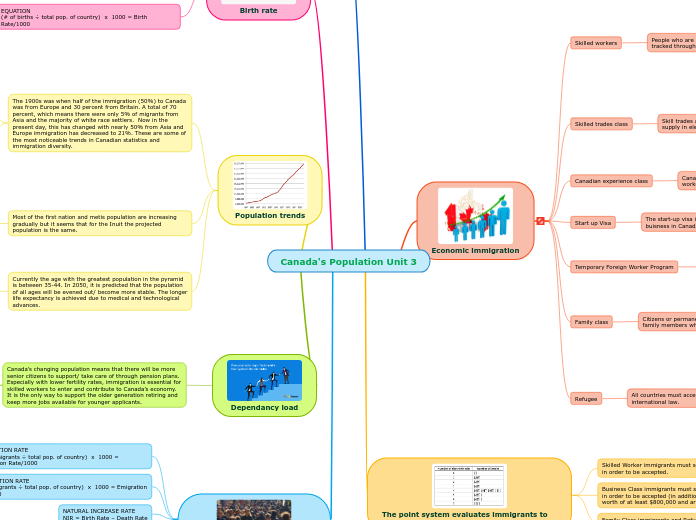Canada's Population Unit 3
Death rate
The number of deaths is increasing, and the projected death rates are high. I think that longer life expectancy leads to more people living to their old age. The lower fertility rates will contribute because the population of seniors is higher, which leads to more deaths in Canada.
EQUATION (# of deaths ÷ total pop. of country) x 1000 = Death Rate/1000
Economic immigration
Skilled workers
People who are identified as high-demand occupations are fast tracked through the system because Canada needs their skills.
Skilled workers
Skilled trades class
Skill trades attract eligible immigrants that help fill the short supply in electrician, plumber, logger, and mine workers.
Skill trades class
Canadian experience class
Canadian experience class accepts immigrants who legally worked in Canada for at least one year.
Start up Visa
The start-up visa is for people that are interested in starting a buisness in Canada.
Start up Visa
Temporary Foreign Worker Program
Temporary foreign workers are given permits to fill labor shortages and people of extraordinary talent to contribute to the economy.
Family class
Citizens or permanent residents are allowed to sponsor close family members who want to move to Canada.
Family class
Refugee
All countries must accept legitimate refugees, under international law.
Refugee
The point system evaluates immigrants to determine qualification.
Skilled Worker immigrants must score at least 67/100 points in order to be accepted.
Business Class immigrants must score at least 35/100 points in order to be accepted (in addition to proving they have a net worth of at least $800,000 and are going to invest in Canada.
Family Class immigrants and Refugees are not judged using the Point System.
Birth rate
CANADA I realize that birth rates were at about 2.5-3 per women until the war ended and it rose to almost 4 per women. After the invention of birth control, there was a downwards slope/ decrease in births. The overall number of births remained at about 1.5 per woman consistently from the 1970s until today.
EQUATION (# of births ÷ total pop. of country) x 1000 = Birth Rate/1000
Population trends
The 1900s was when half of the immigration (50%) to Canada was from Europe and 30 percent from Britain. A total of 70 percent, which means there were only 5% of migrants from Asia and the majority of white race settlers. Now in the present day, this has changed with nearly 50% from Asia and Europe immigration has decreased to 21%. These are some of the most noticeable trends in Canadian statistics and immigration diversity.
European settlers/immigrants
Diverse group of immigrants
Most of the first nation and metis population are increasing gradually but it seems that for the Inuit the projected population is the same.
Inuit
Currently the age with the greatest population in the pyramid is between 35-44. In 2050, it is predicted that the population of all ages will be evened out/ become more stable. The longer life expectancy is achieved due to medical and technological advances.
People aged 35-44
Dependancy load
Canada’s changing population means that there will be more senior citizens to support/ take care of through pension plans. Especially with lower fertility rates, immigration is essential for skilled workers to enter and contribute to Canada’s economy. It is the only way to support the older generation retiring and keep more jobs available for younger applicants.
I think the government needs to address a better balance between youth and adults. In the current dependency load, we are relying too heavily on skilled workers to immigrate. They then would contribute to Canada's economy to support the boomer generation that’s retiring through taxes and, it’s essential to leave more job spots available for youth.
Skilled workers
Other population equations
IMMIGRATION RATE (# of immigrants ÷ total pop. of country) x 1000 = Immigration Rate/1000
EMMIGRATION RATE
(# of emigrants ÷ total pop. of country) x 1000 = Emigration Rate/1000
NATURAL INCREASE RATE
NIR = Birth Rate – Death Rate
NET MIGRATION RATE
NMR = Immigration Rate – Emigration Rate
POPULATION GROWTH RATE
PGR= [(NIR + NMR) ÷ 1000] x 100
DOUBLING TIME
Divide 70 by the population growth rate (70 ÷ PGR)
